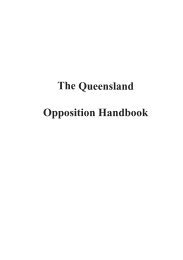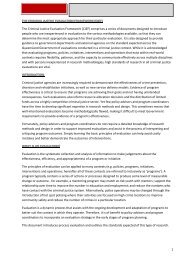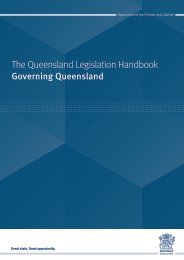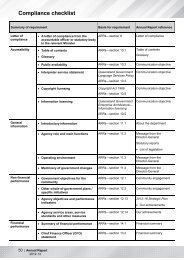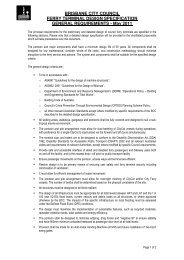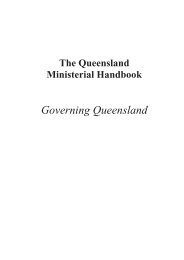Rehabilitative needs and treatment of Indigenous offenders in ...
Rehabilitative needs and treatment of Indigenous offenders in ...
Rehabilitative needs and treatment of Indigenous offenders in ...
Create successful ePaper yourself
Turn your PDF publications into a flip-book with our unique Google optimized e-Paper software.
When <strong>of</strong>fenders go back home, the families celebrate them com<strong>in</strong>g home<strong>and</strong> the dr<strong>in</strong>k<strong>in</strong>g starts all over aga<strong>in</strong>.It was reported that the excessive consumption <strong>of</strong> alcohol <strong>in</strong>creases an<strong>Indigenous</strong> <strong>of</strong>fender’s likelihood <strong>of</strong> be<strong>in</strong>g <strong>in</strong>volved <strong>in</strong> assaults, public disorders<strong>and</strong> breach<strong>in</strong>g orders. A non-government organisation worker believed:Alcohol <strong>and</strong> illicit drug consumption impacts on relationships with<strong>in</strong>the family <strong>and</strong> results <strong>in</strong> violence.<strong>Indigenous</strong> ISDR participants also cited substance misuse as one <strong>of</strong> the ma<strong>in</strong>reasons for re-<strong>of</strong>fend<strong>in</strong>g.Health pr<strong>of</strong>essionals, <strong>Indigenous</strong> Elders <strong>and</strong> non-government organisationworkers referred to the lack <strong>of</strong> substance misuse <strong>treatment</strong> programs <strong>in</strong> thecommunity – especially <strong>in</strong> regional <strong>and</strong> rural areas. The wait<strong>in</strong>g lists for drugrehabilitation programs <strong>in</strong> areas <strong>of</strong> high service concentration (such asBrisbane) were also viewed to be too long for <strong>of</strong>fenders with high <strong>needs</strong>.It is worth not<strong>in</strong>g that a few ISDR participants reported that <strong>in</strong>volvement <strong>in</strong> aQCS substance abuse program provided benefits to some programparticipants. This <strong>in</strong>cluded cessation <strong>of</strong> substance misuse <strong>and</strong> access to<strong>treatment</strong> otherwise not available <strong>in</strong> the community.Offender Education, Vocation <strong>and</strong> Employment ProgramsThe low level <strong>of</strong> education atta<strong>in</strong>ed by <strong>Indigenous</strong> <strong>of</strong>fenders was frequentlyreported as a barrier to <strong>of</strong>fenders participat<strong>in</strong>g <strong>in</strong> QCS programs as well ascontribut<strong>in</strong>g to poor <strong>of</strong>fender rehabilitation <strong>and</strong> re<strong>in</strong>tegration.Custodial staff across various centres, <strong>Indigenous</strong> Elders <strong>and</strong> serviceproviders reported that <strong>Indigenous</strong> <strong>of</strong>fenders who decl<strong>in</strong>ed to participate <strong>in</strong>VET programs felt shame <strong>and</strong> embarrassment about their levels <strong>of</strong> literacy<strong>and</strong> numeracy. A Custodial Officer expla<strong>in</strong>ed:[<strong>Indigenous</strong>] <strong>of</strong>fenders won’t attend because <strong>of</strong> the shame <strong>and</strong> whitefaces try<strong>in</strong>g to teach them.Some custodial staff <strong>and</strong> service providers suggested that the implementation<strong>of</strong> compulsory literacy <strong>and</strong> numeracy programs could reduce the shame thatmay be experienced by <strong>Indigenous</strong> <strong>of</strong>fenders due their low literacy <strong>and</strong>numeracy skills. Access to an education television channel <strong>in</strong> prison cells wasalso advocated.<strong>Indigenous</strong> Elders <strong>and</strong> workers from the health, legal <strong>and</strong> welfare sectorsreported that low skills among <strong>Indigenous</strong> <strong>of</strong>fenders reduce their likelihood <strong>of</strong>f<strong>in</strong>d<strong>in</strong>g employment after their release from custody. ISDR participants alsoacknowledged that post-release employment for <strong>Indigenous</strong> <strong>of</strong>fenders ish<strong>in</strong>dered by a lack <strong>of</strong> employment opportunities <strong>in</strong> rural <strong>and</strong> remote areas <strong>of</strong>63



